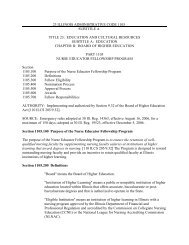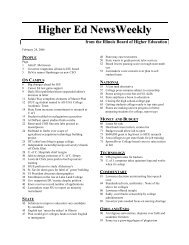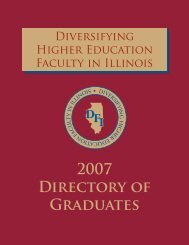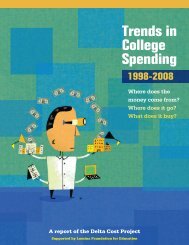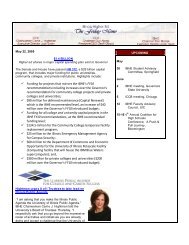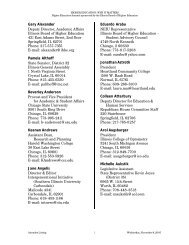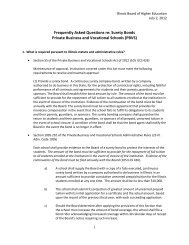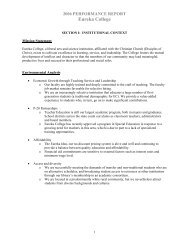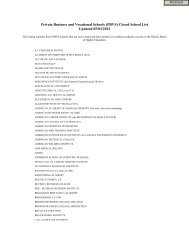A Report on the Feasibility of Textbook Rental - IBHE
A Report on the Feasibility of Textbook Rental - IBHE
A Report on the Feasibility of Textbook Rental - IBHE
You also want an ePaper? Increase the reach of your titles
YUMPU automatically turns print PDFs into web optimized ePapers that Google loves.
Detailed AAP Resp<strong>on</strong>se to Illinois Draft <str<strong>on</strong>g>Report</str<strong>on</strong>g> <strong>on</strong> <strong>Textbook</strong>sEXECUTIVE SUMMARY• The focus <strong>of</strong> textbook legislati<strong>on</strong> has been <strong>on</strong> lowering student spending <strong>on</strong> textbooks, notcurtailing <strong>the</strong> “rising cost” <strong>of</strong> textbooks, as stated in paragraph <strong>on</strong>e. Any reference to “costs” or“prices” could be problematic because <strong>the</strong>y could be c<strong>on</strong>strued as an attempt to regulate prices ormandate publishing business practices and would be unc<strong>on</strong>stituti<strong>on</strong>al and violati<strong>on</strong>s <strong>of</strong> <strong>the</strong> FirstAmendment to <strong>the</strong> C<strong>on</strong>stituti<strong>on</strong> and <strong>the</strong> U.S. Commerce Clause. See Appendix A – Weil,Gotshal, Manges letter.• In paragraph <strong>on</strong>e, line two <strong>of</strong> <strong>the</strong> Summary <strong>the</strong> sentence reads “remedies to <strong>the</strong> financial burdencollege students face.” According to studies, 50 percent or more <strong>of</strong> students are unc<strong>on</strong>cernedabout <strong>the</strong> price <strong>of</strong> textbooks. For balance, you might want to change <strong>the</strong> sentence to read “somecollege students.”Findings• Bullet 1, page 5 – The Government Accountability Office report is cited incorrectly. The costinformati<strong>on</strong> is based <strong>on</strong> figures from 1987 to 2004, not 2005. Additi<strong>on</strong>ally, <strong>the</strong> C<strong>on</strong>sumer PriceIndex (CPI) used by <strong>the</strong> Government Accountability Office (GAO) includes any book designatedas a required text, which could include many novels, technical books, pr<strong>of</strong>essi<strong>on</strong>al journals, etc.that are not sold or distributed by individual publishers <strong>of</strong> postsec<strong>on</strong>dary textbooks. AAPobjected to <strong>the</strong> CPI figure that, by its own disclaimer in <strong>the</strong> GAO report, before 2001, did notaccurately reflect <strong>the</strong> increasing penetrati<strong>on</strong> <strong>of</strong> lower-cost alternatives that are replacingunabridged, hardcover texts. C<strong>on</strong>sequently, Bureau <strong>of</strong> Labor Statistics (BLS) data exaggeratestextbook price increases over <strong>the</strong> course <strong>of</strong> <strong>the</strong> reporting period. On page 32 <strong>of</strong> <strong>the</strong> report, GAOalso acknowledges "textbooks are increasingly wrapped in packages al<strong>on</strong>g with additi<strong>on</strong>almaterials, making it difficult to collect all <strong>of</strong> <strong>the</strong> qualitative characteristics <strong>of</strong> <strong>the</strong> textbooks. As aresult, it is difficult for BLS to obtain <strong>the</strong> informati<strong>on</strong> necessary for quality adjustment, and o<strong>the</strong>rtimes <strong>the</strong> price recorded as <strong>the</strong> textbook price may also include ancillary materials."A paper entitled “Faculty Selecti<strong>on</strong> and Use <strong>of</strong> Publisher-Provided <strong>Textbook</strong>s and SupplementaryMaterials in <strong>the</strong> United States” released <strong>on</strong>ly last week also addresses <strong>the</strong> weaknesses in <strong>the</strong> CPI’spricing model (see page 12).(www.immagic.com/eLibrary/ARCHIVES/GENERAL/IMM/I061215F.pdf)• The numbers <strong>on</strong> spending by Illinois students appear to be far higher than those cited for studentsin o<strong>the</strong>r states. Is <strong>the</strong>re a reas<strong>on</strong> for this difference in spending? The report could also providec<strong>on</strong>text by explaining <strong>the</strong>se costs as a percentage <strong>of</strong> total educati<strong>on</strong>al costs, including tuiti<strong>on</strong> andfees, room and board, and transportati<strong>on</strong> costs. <strong>Textbook</strong> costs for two-year and four-yearstudents average between six and seven percent <strong>of</strong> annual educati<strong>on</strong>al costs, according to <strong>the</strong>College Board’s Trends in College Pricing, 2006.• Bullet 4, page 6 --o Bundling – A textbook packaged with supplemental learning materials will, as <strong>on</strong>e wouldexpect, generally cost more than a standal<strong>on</strong>e textbook just as a car or computer withadded features will cost more than those without extra features. The benefit <strong>of</strong> <strong>the</strong>package is that, collectively, <strong>the</strong> materials cost less that when sold separately. Publisherscan and do sell supplemental materials separately. This practice <strong>of</strong> separate sales doesnot, as some suggest, reduce students’ spending if <strong>the</strong>y purchase all <strong>of</strong> <strong>the</strong> materialsadopted for <strong>the</strong>ir class by <strong>the</strong>ir instructor.o Publicati<strong>on</strong> <strong>of</strong> new editi<strong>on</strong>s – Although <strong>the</strong>re is a great debate over <strong>the</strong> issuance <strong>of</strong> newediti<strong>on</strong>s, recent research by Nebraska Book Company, <strong>on</strong>e <strong>of</strong> <strong>the</strong> country’s largest used-72-



